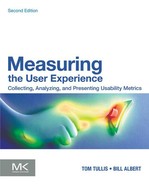Preface to the Second Edition
Welcome to the second edition of “Measuring the User Experience!” The world of user experience, or UX as it’s often abbreviated, has changed quite a bit since the first edition of this book was published. In early 2008 the iPad didn’t exist yet nor did Android-powered smartphones. The iPhone was still in its infancy; Pinterest, as well as many other social-networking sites, hadn’t even been thought of yet; and the Google Chrome browser was just a rumor. We mention those devices and services because they have helped shape users’ experiences with and expectations of the technology many people use on a daily basis. Users expect to be able to pick up a new application or device and start using it right away. Making sure they can is where this book comes in.
UX covers all aspects of someone’s interaction with a product, application, or system. Many people seem to think of the user experience as some nebulous quality that can’t be measured or quantified. We think it can be. And the tools for measuring it are metrics like the following:
• Can users use their smartphone successfully to find the nearest doctor that’s in their health plan?
• How long does it take users to make a flight reservation using a travel website?
• How many errors do users make in trying to log in to a new system?
• How many users are successful in using their new tablet application to instruct their digital video recorder to record all episodes of their favorite TV show?
• How many users get into a new “destination-based” elevator without first choosing their desired floor, only to discover there are no floor buttons?
• How many users get frustrated trying to read the tiny serial number hidden under the battery of their new mobile phone when registering for service?
• How many users are delighted by how easy it was to assemble their new bookcase that came with wordless instructions?
These are all examples of behaviors and attitudes that can be measured. Some may be easier to measure than others, but they can all be measured. Success rates, times, number of mouse clicks or keystrokes, self-reported ratings of frustration or delight, and even the number of visual fixations on a link on a web page are all examples of UX metrics. And these metrics can give you invaluable insight into the user experience.
Why would you want to measure the user experience? The answer is simple: to help you improve it. With most consumer products, apps, and websites these days, if you’re not improving, you’re falling behind. UX metrics can help you determine where you stand relative to your competition and help you pinpoint where you should focus your improvement efforts—the areas that users find the most confusing, inefficient, or frustrating.
This book is a how-to guide, not a theoretical treatise. We provide practical advice about what metrics to collect in what situations, how to collect them, how to make sense of the data using various analysis techniques, and how to present the results in the clearest and most compelling way. We’re sharing practical lessons we’ve learned from our 40+ combined years of experience in this field.
This book is intended for anyone interested in improving the user experience for any type of product, whether it’s a consumer product, computer system, application, website, or something else altogether. If it’s something people use, then you can measure the user experience associated with it. Those who are interested in improving the user experience and who could benefit from this book come from many different perspectives and disciplines, including usability and UX professionals, interaction designers, information architects, product designers, web designers and developers, software developers, graphic designers, and marketing and market-research professionals, as well as project and product managers.
So what’s new in this second edition of the book? Here are some of the highlights:
• New technologies for measuring emotional engagement, including wrist sensors and automated analyses of facial expressions.
• Advances in eye-tracking technology, including remote webcam-based eye tracking.
• New case studies, including examples of what people in the UX field are working on right now. (Chapter 10, Case Studies, is entirely new.)
• New methods and tools for collecting and analyzing UX data, including a variety of online tools.
We hope that you find this book helpful in your quest to improve the user experience for your products. We’d like to hear about your successes (and failures!). We really value the feedback and suggestions that many readers have given us about the first edition. Much of that feedback helped shape the changes and additions we made in this edition. You can contact us through our website, www.MeasuringUserExperience.com. You will also find supplementary material there, such as the actual spreadsheets and graphs for many of the examples in this book, as well as information about tools that can help in measuring the user experience.
